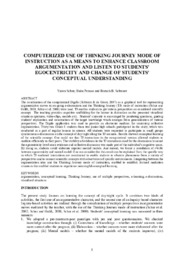| dc.contributor.author | Schur, Yaron | en |
| dc.contributor.author | Pensso, Haim | en |
| dc.contributor.author | Schwarz, Baruch B. | en |
| dc.coverage.spatial | CY - Λευκωσία | en |
| dc.date.accessioned | 2016-01-21T10:51:37Z | |
| dc.date.available | 2016-01-21T10:51:37Z | |
| dc.date.issued | 2008 | |
| dc.identifier.uri | http://hdl.handle.net/10797/14479 | en |
| dc.description | Περιέχει το πλήρες κείμενο | el_GR |
| dc.description.abstract | The combination of the computerized Digalo (Schwarz & de Groot, 2007) as a graphical tool for representing
argumentative moves in on-going e-discussions and the Thinking Journey (TJ) mode of instruction (Schur and
Galili, 2009, Schur et al. 2009) were used. TJ enables students to get various perspectives on considered scientific
concept. The teaching provides cognitive scaffolding for the learner in discussion on the presented visualized
situations (pictures, video-clips, models etc). Students' curiosity is encouraged by pondering questions, guiding
students' exploration and construction of the target knowledge which emerges from generalization of various
perspectives. The Digalo application was used to provide an electronic medium for sustaining collective
argumentation. Thirty-two Grade 8 students from two junior-high schools participated in the study, which was
conducted as a part of regular lessons in science. All students were requested to participate in small groups
synchronous e-discussions on the concept of day/night along the TJ scenario. Results showed conceptual learning
of the scientific concept. One could see that TJ interactions in the computerized version allowed students to
mediate efficiently to their peers. The visibility of evidence in the TJ interactions used for the discussions lessened
the egocentricity level since evidence and collective discussion was made part of the individual's cognitive space.
By doing so, students could elaborate superior mental models. And indeed, we found a correlation of r=6.06
between egocentricity and mental model. One can consider that this result can be explained from the specific way
in which TJ mediated interactions are constructed to enable students to observe phenomena from a variety of
perspectives and to connect scientific concepts with observation of specific environments. Integrating between the
argumentation idea and the Thinking Journey mode of instruction, enabled to establish focused mediation
situations that enabled students to experience meaningful conceptual learning. | en |
| dc.language.iso | eng | en |
| dc.publisher | University of Cyprus | en |
| dc.relation.ispartof | Thinking through Physics education | en |
| dc.rights | info:eu-repo/semantics/openAccess | en |
| dc.title | Computerized use of thinking journey mode of instruction as a means to enhance classroom argumentation and listen to students' egocentricity and change of students' conceptual understanding | en |
| dc.type | info:eu-repo/semantics/conferenceObject | en |
| dc.subject.uncontrolledterm | Argumentation | en |
| dc.subject.uncontrolledterm | Conceptual learning | en |
| dc.subject.uncontrolledterm | Thinking Journey | en |
| dc.subject.uncontrolledterm | Use of multiple perspectives | en |
| dc.subject.uncontrolledterm | E-learning | en |
| dc.subject.uncontrolledterm | E-discussions | en |
| dc.subject.uncontrolledterm | Visualized situations | en |
| dc.contributor.conferenceorganizer | Department of Educational Science, University of Cyprus | en |
